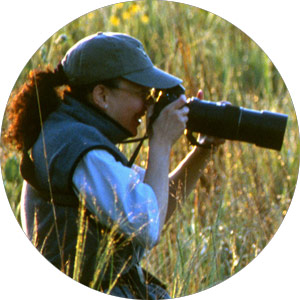One Shot: Crop Factor
It was a field test, pure and simple. Carol Freeman's AF VR Zoom-Nikkor 80-400mm f/4.5-5.6D ED was one of her essential lenses for her nature photography, but with an AF-S NIKKOR 80-400mm f/4.5-5.6G ED VR now available, she wondered if it was time to upgrade. The key question: what difference would the new version make? It was, after all, the same focal length and nearly the same f/stop range as the older lens. Sure, it was an AF-S lens (meaning it has a silent wave motor for faster, quieter autofocusing), and it was an internal focusing lens (meaning the internal lens group moves during focusing, with no effect on the external length of the lens), and all of that was good news—but what would it all mean to her photographs?
To find out, she borrowed an AF-S 80-400mm and took to the trail. Weeks later Carol's comments, and a few JPEGs, reached us. "I'm blown away by this lens!" she wrote. "The quality of the images is incredible. I've attached a few shots (cropped to show detail)." This duck feather photo was one of the images Carol sent.
It took a few moments for the "cropped to show detail" part to sink in, and when it did, we wrote back: "Send the uncropped shot, will you?"
When we got the original, we really got the message Carol was communicating: not only high-quality images, but "crop-in" ability as well.
"I saw it on the monitor when I got the images home," Carol says.
"That lens is giving me a three-dimensionality to the photographs that just wasn't there before, and incredible detail in black and shadowed areas of the photos. I'm stunned at the difference." (Yes, we did ask about the obvious control factor of the test: the older lens was used on the same camera—a D600—as the newer one.)
"This is a tiny feather," Carol says, "maybe two inches long. See the reflection of the feather in the water below it? Pretty amazing."
Another benefit for Carol, who shoots lots of close-ups, was the AF-S lens's shorter close-focusing distance—5.74 feet versus 7.5 feet for the older 80-400mm.
"This lens makes me a better photographer," she says. "I can take better pictures because of it, and I never thought I'd say that about a piece of equipment."
Not only better, but a bit different, too: "I hardly ever used autofocus," she says, "but with this lens the AF is so fast, I'm using it for shots of birds in flight—and even for the feather. And I like that I can go back and forth from AF to manual with just a flick of my thumb on the switch on the lens barrel."
The test result: When the lens lender calls it home, Carol will be making a purchase.
The image specs: D600, AF-S NIKKOR 80-400mm f/4.5-5.6G ED VR, 1/1000 second, f/8, ISO 1000, aperture priority, Matrix metering.







